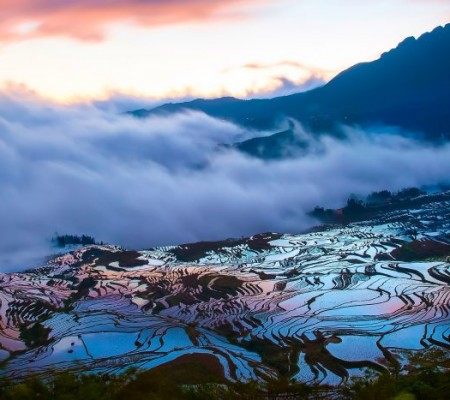
Doushaguan Scenic Area in Yanjin County, Zhaotong

Attraction Overview
Doushaguan Scenic Area is located 20 kilometers from the county seat of Yanjin County in the northeast of Yunnan. It is composed of 60 scenic spots in four areas, covering an area of about 70 square kilometers.
Chinese Name: 豆沙关风景区(Pinyin: Doushaguan Fengjingqu)
Best Time to Visit: All-year-round
Recommended Visiting Time: Half Day
Admission Fee: CNY 40
Location: 20 kilometers from the county seat of Yanjin County, Zhaotong City, northeast of Yunnan Province
Doushaguan Scenic Area is located 20 kilometers from the county seat of Yanjin County in the northeast of Yunnan. It is composed of 60 scenic spots in four areas, including the spectacular and rugged ancient post road, the Doushaguan, dazzling Laolishan mountain scenery, well-visited domes and limestone peaks, dreamlike natural maze, rare and precious herbs & flowers all over the hills, towering trees, picturesque Sangushui waterfall as well as rich ancient cultural relics, covering an area of about 70 square kilometers. It is a tourist attraction along the way from northeast Yunnan to Sichuan and northwest China. Doushaguan pass has served as the first pass for those who entered Yunnan from Sichuan as one can see the existent Five-Chi passage that was built the Qin Dynasty (221 BC-206 BC). A pavilion named “Tang Bei Ting” has been built at Dousha Pass, where one could appreciate the cliff carvings by Yuan Zi, a procurator and famous calligrapher in the Tang Dynasty (618-907). On the opposite of the pavilion, one could further see the miraculous Suspended Coffins of Bo people.

The Dousha Pass Scenic Area in Yanjin County, Zhaotong, Yunnan, is one of the province’s most unique attractions. Located just 20 kilometers from the county seat, the area spans approximately 70 square kilometers and features four main districts with 60 scenic spots. This area is rich in natural beauty and historical significance, making it an important tourist destination in northeastern Yunnan.
Overview of Dousha Pass Scenic Area
The Dousha Pass Scenic Area (豆沙关风景名胜区) consists of four main sections: Dousha Pass, Sangushui (三股水), Lianhua Cave (莲花洞), and Dali Mountain (大黎山), each offering unique landscapes and cultural heritage. Together, they cover about 70 square kilometers. The area is renowned for its ancient military pass, scenic mountains, mysterious caves, and abundant flora and fauna.
Major Attractions
1. Dousha Pass: The Majestic Ancient Military Route
Dousha Pass (豆沙关), formerly known as Shimen Pass (石门关), was a crucial military stronghold in ancient China. Situated 22 kilometers southwest of Yanjin County, it was the first major pass for travelers moving from Sichuan into Yunnan. The towering cliffs of Dousha Pass form a massive stone gateway that once controlled the passage between Yunnan and Sichuan, earning it the title “The First Pass in Southern Yunnan” (滇南第一关).
The ancient “Five-Cun Road” (五尺道) is a notable relic here. Dating back over 2,200 years, this road was originally built during the Qin Dynasty. It stretches about 350 meters, with stone steps worn smooth by the passage of time and the hoofprints of countless travelers and animals. This road formed a key part of the “Sichuan-Yunnan-Myanmar-India” route, known as the ancient Southwestern Silk Road.
A highlight of Dousha Pass is the Tang Dynasty inscription carved by Yuan Zi (袁滋), a famous calligrapher and official from the Tang Dynasty. Yuan Zi etched his name and a tribute to the pass on the cliff in 794 AD. This inscription is now considered a national cultural heritage site. Opposite the inscription is the mysterious “Bo People Hanging Coffins” (僰人悬棺), an ancient burial site perched high on a cliff, adding to the area’s intrigue.

2. Dali Mountain: Scenic Beauty Across the Seasons
The Dali Mountain (大黎山) area, within the Dousha Pass Scenic Zone, is known for its breathtaking natural beauty. The mountains here are a photographer’s dream, offering a panorama of stunning landscapes across all four seasons. In spring, the slopes are covered with blooming rhododendrons; in summer, lush trees provide cooling shade; in autumn, fiery red leaves blanket the ground; and in winter, snow transforms the area into a winter wonderland.
3. Sangushui Waterfall: A Picturesque Natural Wonder
The Sangushui (三股水) Waterfall is another must-see attraction within the Dousha Pass Scenic Area. The cascading waters create a mesmerizing sight as they tumble down from great heights, creating a refreshing mist and a roaring sound. The waterfall is surrounded by lush greenery, adding to the tranquil beauty of the area. Its dramatic presence makes it one of the most scenic spots in the region.
4. Lianhua Cave: A Mysterious Natural Maze
Lianhua Cave (莲花洞) is an intriguing natural formation within the scenic area. The cave’s winding passages and hidden chambers create a natural maze that attracts adventurers and explorers alike. The stalactites and stalagmites inside are shaped in fantastic forms, adding an element of mystery and wonder to the cave’s interior.
5. Ancient Trees: Living Witnesses of History
The area is also home to towering ancient trees that stand as silent witnesses to the passage of time. These monumental trees provide shelter from the sun, but they also evoke a sense of awe, their age and grandeur linking visitors to the ancient history of the region.
6. Rich Cultural Heritage: Traces of the Past
Beyond its natural beauty, Dousha Pass is steeped in cultural history. The remnants of ancient roads, bridges, and waystations reflect the vibrant history of the region, providing visitors with a deeper understanding of the past. These cultural relics serve as a connection between the modern world and the centuries of history that shaped this part of Yunnan.

Travel Tips
How to Get There
Dousha Pass is located 22 kilometers southwest of Yanjin County in Zhaotong City, Yunnan. Here are the best ways to reach the area:
- By Car: The most convenient way to reach Dousha Pass is by driving. The road is well-maintained, and the journey from Yanjin County to the pass takes approximately 30-40 minutes.
- By Bus: Buses run regularly from Yanjin County to the Dousha Pass Scenic Area. The journey takes around an hour, and tickets are affordable.
Best Time to Visit
- Spring: Ideal for those who want to see the colorful rhododendrons in bloom.
- Autumn: Enjoy the vibrant red foliage on the mountain slopes.
- Winter: If you enjoy winter scenery, the snow-covered landscape in Dali Mountain is a must-see.
What to Bring
- Comfortable Footwear: Some areas, especially the ancient roads and cliffs, may be steep or uneven, so sturdy shoes are recommended.
- Water and Snacks: While there are some local food vendors, it’s always a good idea to carry some water and snacks.
- Camera: The scenery, from the waterfalls to the ancient trees, is incredibly picturesque—don’t forget your camera.
What to Expect
- Weather: The region has a mild, temperate climate, but it can be a little cooler at higher altitudes. Be prepared for sudden weather changes.
- Crowds: While not as crowded as some other tourist destinations, weekends and holidays may bring more visitors, especially to popular spots like the waterfalls and ancient pass.
Key Attractions Recap:
- Dousha Pass (豆沙关): The ancient military pass, home to the “Five-Cun Road” and Tang Dynasty inscriptions.
- Sangushui Waterfall (三股水瀑布): A stunning waterfall that is a visual spectacle.
- Dali Mountain (大黎山): Scenic beauty with different faces in each season.
- Lianhua Cave (莲花洞): A natural maze with fascinating stalactites and stalagmites.
- Bo People Hanging Coffins (僰人悬棺): Mysterious ancient burials perched on cliffs.
- Ancient Trees: Majestic trees that have stood the test of time, enhancing the area’s natural splendor.
Visit Dousha Pass for a memorable experience where history and nature intertwine, offering visitors both adventure and reflection.


 7 Days GolfingTour
7 Days GolfingTour
 8 Days Group Tour
8 Days Group Tour
 8 Days Yunnan Tour
8 Days Yunnan Tour
 7 Days Shangri La Hiking
7 Days Shangri La Hiking
 11 Days Yunnan Tour
11 Days Yunnan Tour
 6 Days Yuanyang Terraces
6 Days Yuanyang Terraces
 11 Days Yunnan Tour
11 Days Yunnan Tour
 8 Days South Yunnan
8 Days South Yunnan
 7 Days Tea Tour
7 Days Tea Tour
 8 Days Muslim Tour
8 Days Muslim Tour
 12 Days Self-Driving
12 Days Self-Driving
 4 Days Haba Climbing
4 Days Haba Climbing
 Tiger Leaping Gorge
Tiger Leaping Gorge
 Stone Forest
Stone Forest
 Yunnan-Tibet
Yunnan-Tibet
 Hani Rice Terraces
Hani Rice Terraces
 Kunming
Kunming
 Lijiang
Lijiang
 Shangri-la
Shangri-la
 Dali
Dali
 XishuangBanna
XishuangBanna
 Honghe
Honghe
 Kunming
Kunming
 Lijiang
Lijiang
 Shangri-la
Shangri-la
 Yuanyang Rice Terraces
Yuanyang Rice Terraces
 Nujiang
Nujiang
 XishuangBanna
XishuangBanna
 Spring City Golf
Spring City Golf
 Snow Mountain Golf
Snow Mountain Golf
 Stone Mountain Golf
Stone Mountain Golf



